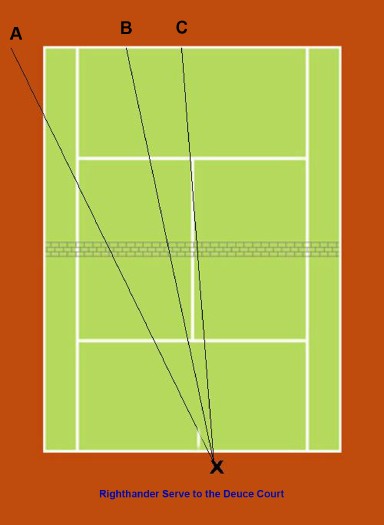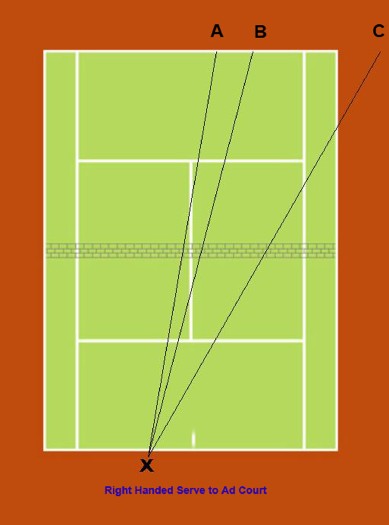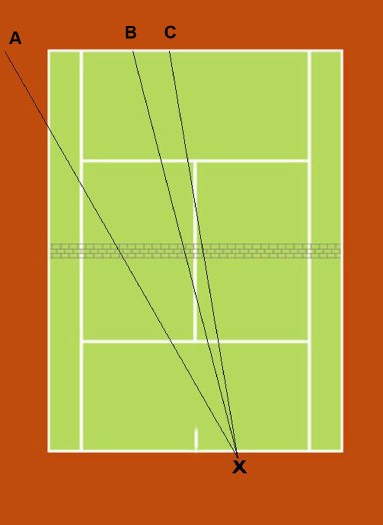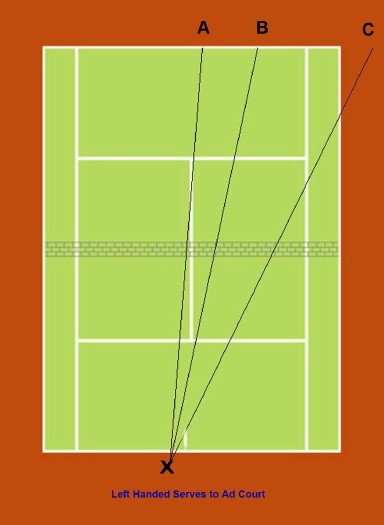December 2004 Article Turbo Tennis Archives:
Tennis Server
|

 |
Well, here we are in December, and I want to wish all of you the best of Holiday Seasons. We who live north of the Equator, are for the most part limited to indoor tennis competition and training. Those of you who are citizens of the lower hemisphere are enjoying the beginning of what is the heart of your summer months. The tennis players on the college team that I coach are always surprised to see that I am not afraid to take find ways of practicing, despite the cold and snow. No. I am not so foolish as to believe that I can shovel a court and play a "safe" game of tennis. First, there exists the real possibility that I could slip and injure myself. The severe cold limits the bounce of the balls. They become almost instantly "dead." Finally, at my advanced age, the cold takes its toll fairly quickly. But, there is one facet of my game that I usually can practice…my serve. Now, don’t get me wrong. I am not one who is going to shovel off three feet of snow on an outdoor court to practice my serve. But, every so often, I luck out and I can find a court that is fairly clear of any snow or ice. When I do, I do not hesitate to practice an extra 100 serves. When practicing indoors during the winter months, I will always spend at least one full practice session per week working on nothing but my serve. Believe me--even with a discounted hourly rate, indoor time is not cheap. But serving well is just too important to neglect. For those of you who are enjoying the heat of summer, I still cannot urge you enough to practice your serve! Why? Well, the serve is the only stroke in the game that you get two attempts to get it right! Thus, it is not to my liking to double fault. Second, the serve is the only shot that you completely control. You are not hitting the ball off of a bounce and you are always in the right court position. Most important, however, is the reality of tennis scoring. If you never lose your service, you cannot lose the match!!! I have written a lot about service technique in my past articles. I encourage the reader to review all my past articles, which are available through the Turbo Tennis Archives:
However, this month, I do not want to address the stroke techniques associated with the serve. Rather, I want to speak to the strategies and patterns associated with your serves. Of course, to take advantage of a service strategy, you need to have control over your serve placement, spin and pace. Notice the order in which I have placed the above elements. The most important aspect of serving is being able to place the serve in one of several "spots" in each service box (deuce and ad). Spin is essential to develop… especially for second serves. Spinning your serves greatly increases the likelihood that the serve will land within the service box. The last, and, in some aspects, the least important component in a serve is its pace. Still, many of us strive to become the new Andy Roddick or Brenda Schultz. Few of us are this gifted. Let’s discuss the way to practice serves. Because placement is most important, I am always serving at targets. My targets are either little pyramids made from old tennis balls, or more likely, I use empty tennis ball containers. I place them in three different spots in each of the two service boxes. Below, you will find four diagrams of the three serves that every player needs to have with respect to placement. Although I am right handed, I am sensitive to the needs of lefties. So, you will see that these diagrams are labeled for both right handed and left handed players. You can click on each diagram to get an enlarged version of each graphic in a new window. The first thing to note in each of these diagrams is that there are wide, center and "T" serves. A player needs to be able to hit each of these…on both the deuce and the ad sides. When practicing my serves, I place my "targets" in such positions that facilitate each of these three general serve placements. Now, I should mention two things. First, place your targets deep in the service box but not on the service line. Why? Well the lines are boundaries, not targets. Any serve that lands deep in the box is a good and aggressive serve!!! But in reality, you need to provide yourself with a margin for error. After all, we are only human. Second, you should not expect to actually hit these targets very often. If you hit the intended target 1 out of every 20 serves, you are doing very well. When I watch the pros train this way at tournaments that I photograph, I must tell you that their percentages are not much better. However, having a physical target really helps to focus your toss, timing and mental focus…these are the three things that breakdown first when we are excessively nervous or losing. Now when it comes to second serves, I try to follow the lead of the pros. I use the kick serve (one that has spin that makes it bounce higher than is normally the case and usually travels with a little side spin). I have played entire matches where the only serve that I have used is the kick serve…and I have won more of these matches than I have lost!!! I am not a major advocate of the slice serve, but if this is your only spin serve, by all means use it!!! The slice serve works extremely well as a first serve on fast surfaces like grass and many indoor services. It can be a real liability on slow surfaces such as clay. Out of 100 serves, I will make certain that 50 are directed at the deuce court and 50 at the ad court. However, I will only make about 20 of these 100 serves that are designed to be "heaters" (serves with pace). I only serve 10 serves to either side of the court before moving to serve to the other. Why? Well, in matches, we are changing sides every serve. I want to replicate this reality in my practice sessions. So, that leads us to the concepts of strategy and pattern when serving. I wish there were a single set of tactics that would work with every player on every surface. Alas, this is just not the case. But, let me end this month’s column with some concepts that seem to work more often than not.
If you are repeatedly playing the same opponents, you can invariably develop a pattern of serving. I encourage tournament players to keep "record books" on opponents. You may find that some patterns are successful on one surface and devastating on another. Again, you need to be aware of who you are playing and where! But, if you spend more time practicing your serve and follow the guidelines that I have listed above, I assure you that in a very short time, you will be not just serving…but serving with a strategy in mind. When your game reaches this level, you are well on your way to becoming a tennis overdog!
1996 - 2002 | 2003 - Present
This column
is copyrighted by Ron Waite, all rights reserved. Questions and comments
about these columns can be directed to Ron by using this form.
Ron Waite is a certified USPTR tennis instructor who took up the game
of tennis at the age of 39. Frustrated with conventional tennis methods
of instruction and the confusing data available on how to learn the
game, Ron has sought to sift fact from fiction. In his seven years of
tennis, Ron has received USTA sectional ranking four years, has successfully
coached several NCAA Division III men's and women's tennis teams to
post season competition, and has competed in USTA National singles tournaments.
Ron has trained at a number of tennis academies and with many of the
game's leading instructors.
In addition to his full-time work as a professor at Albertus Magnus
College, Ron photographs ATP tour events for a variety of organizations
and publications. The name of his column, TurboTennis, stems from his
methods to decrease the amount of time it takes to learn and master
the game of tennis.
|



October 2022 Tennis Anyone: Patterns in Doubles by John Mills. September 2022 Tennis Anyone: Short Court by John Mills. |
 You will join 13,000 other subscribers in receiving news of updates to the Tennis Server along with monthly tennis tips from tennis pro Tom Veneziano.
You will join 13,000 other subscribers in receiving news of updates to the Tennis Server along with monthly tennis tips from tennis pro Tom Veneziano. 



